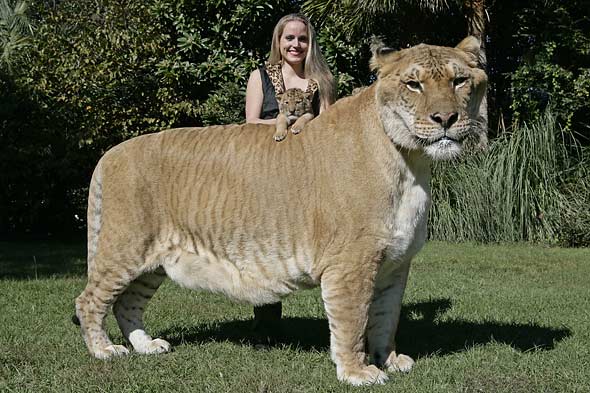Good evening to all our rabid readers.
Aoife here with Saturdays post.
This weeks topic is "Cats" so my post is about a cat that I didn't know existed until last week.
Ligers are the offspring of male lion with a tigress. Ligers are the world's biggest cats, larger than either of their parents, with the strength of a lion and speed of a tiger combined. An average male liger stands almost 12ft tall on its hind legs and weighs up to 450 kgs, twice the weight of a wild lion or tiger.As the liger cub is so much larger than a tiger cub the tigress normally requires a C-section to give birth.
Liger do not exist in the wild as lions and tigers are not found in the same areas. The only ligers known to be in existence have been bred in captivity. Ligers are infertile and can not reproduce. Ligers are prone to genetic diseases and generally die young.
Here's one of the articles I found on ligers:
Ligers Make a “Dynamite” Leap Into the Limelight
by: Maryann Mott August 5, 2005
It’s half lion, half tiger, and completely real. Now thanks to a cameo in the 2004 cult movie Napoleon Dynamite, the liger has leaped into the limelight, prompting fans to ask, What are they really like?
The faintly striped, shaggy-maned creatures are the offspring of male lions and female tigers, which gives them the ability to both roar like lions and chuff like tigers-a supposedly affectionate sound that falls somewhere between a purr and a raspberry.
Weighing in at about a thousand pounds (450 kilograms) each, they typically devour 50 pounds (23 kilograms) of raw meat in a meal.
“For the most part they’re really laid back,” said Jason Hutcherson, vice president of Wild Animal Safari in Pine Mountain , Georgia . “They like to swim and play in the water.”
The drive-through wildlife park is believed to have the country’s largest concentration of ligers, housing ten of the massive cats.
Since 1999 the park has bred its male lion and female tiger many times, producing about 24 cubs.
Not all of them have been healthy, though.
 “We’ve had 3 out of 24 that, for all practical purposes, were normal but developed as they grew older some kind of neurological disorder,” Hutcherson said.
“We’ve had 3 out of 24 that, for all practical purposes, were normal but developed as they grew older some kind of neurological disorder,” Hutcherson said.
Autopsies didn’t reveal what caused the cubs to develop “head shakes,” so park staff “chalked it up to a genetic defect,” Hutcherson said.
Accredited zoos frown on the practice of mixing two different species and have never bred ligers, says Jane Ballentine, a spokesperson for the American Zoo and Aquarium Association, based in Silver Spring , Maryland.
“Keeping the two species separate has always been standard procedure,” she said.
See you next week,
Aoife
See you next week,
Aoife


No comments:
Post a Comment